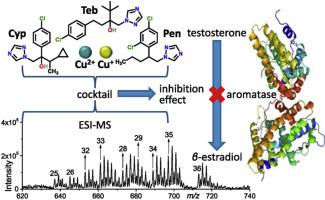Environmental Pollution ( IF 8.9 ) Pub Date : 2020-07-09 , DOI: 10.1016/j.envpol.2020.115201 Jana Jaklová Dytrtová 1 , Kateřina Bělonožníková 2 , Michal Jakl 3 , Helena Ryšlavá 2

|
Triazoles are used as antifungal agents, they mostly inhibit two enzymes: 14α-demethylase and aromatase. These enzymes are utilised also in other species and therefore the affection in non-target species in the environment is expected as well. Besides, triazoles are often being applied in a mixture and they can also interact with other substances present. This study clarifies how three selected representative triazoles (tebuconazole, penconazole and cyproconazole) interact with each other (group effect) and in mixtures (cocktail effect) with copper, essential/toxic for all organisms. Within the experiments on electrospray and collision-induced dissociations (both ESI-MS), it has been found that the fragments correspond to typical triazole metabolites. For their formation, the presence of copper ions is crucial. The inhibitory effect of Cu cocktails on aromatase enzymatic activity has been studied. The presence of Cu ions together with triazole(s) significantly increases the inhibitory effect on aromatase activity. The highest inhibitory effect (more than 60%) on aromatase activity is produced by cocktails containing penconazole and Cu ions, namely by penconazole/Cu and penconazole/tebuconazole/Cu. The reactivity of triazoles in groups is not significantly affected by the interactions among them. Additionally, the role of triazoles in copper Fenton reaction regulation has been observed and described. These changes may be attributed to the formation and stabilization of the complexes with the central Cu ion, with usually one, two or three triazolic ligands, depending on the mixture. The study demonstrates that the interaction of triazoles and Cu ions is a complex process; their impact on metabolism seems to be rather extensive and must be evaluated in the context of biochemical reactions.
中文翻译:

三唑和芳香酶:铜鸡尾酒的影响。
三唑用作抗真菌剂,它们主要抑制两种酶:14α-脱甲基酶和芳香酶。这些酶也可用于其他物种,因此也有望影响环境中的非目标物种。此外,三唑通常以混合物形式使用,它们也可以与存在的其他物质相互作用。这项研究阐明了三种选定的代表性三唑(戊唑醇,戊康唑和环丙唑)如何相互作用(群效应)和与铜的混合物(鸡尾酒效应),这对所有生物都是必不可少的/有毒的。在有关电喷雾和碰撞诱导解离的实验(均为ESI-MS)中,已发现这些片段对应于典型的三唑代谢物。对于它们的形成,铜离子的存在至关重要。已经研究了Cu混合物对芳香酶活性的抑制作用。铜离子与三唑类物质的共同存在显着增加了对芳香化酶活性的抑制作用。含有戊康唑和铜离子的鸡尾酒,即戊康唑/铜和戊康唑/戊康唑/铜,对芳香酶活性的抑制作用最高(超过60%)。组中三唑的反应性不受它们之间相互作用的显着影响。另外,已经观察到并描述了三唑在铜芬顿反应调节中的作用。这些变化可归因于与中心Cu离子(通常具有一个,两个或三个三唑配体)的配合物的形成和稳定,这取决于混合物。研究表明,三唑与铜离子的相互作用是一个复杂的过程。它们对代谢的影响似乎相当广泛,必须在生化反应的背景下进行评估。


























 京公网安备 11010802027423号
京公网安备 11010802027423号